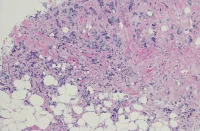Breast cancer is the most common cancer among women worldwide and remains a significant cause of cancer-related mortality. Traditional diagnostic approaches rely on biopsies and histopathological examinations to determine the prognosis and guide treatment. However, non-invasive imaging techniques, such as Ultrasound-Guided Diffuse Optical Tomography (US-guided DOT) and Shear Wave Elastography (SWE), have emerged as promising tools in distinguishing between benign and malignant breast lesions. These methods provide valuable information about tissue characteristics, potentially enabling earlier diagnosis and a better understanding of a tumour’s biological features. A recent study published in The Association of University Radiologists explored the combined use of US-guided DOT and SWE to evaluate breast cancer’s biological characteristics and the potential of these techniques to improve patient outcomes.
Shear Wave Elastography (SWE): A Measure of Tissue Stiffness
SWE is an advanced ultrasound technique that measures tissue stiffness by detecting the speed at which shear waves move through breast tissue. A key feature of SWE is its ability to quantify elasticity parameters, such as maximal elasticity (Emax), mean elasticity (Emean), and standard deviation of elasticity (Esd). Higher elasticity values indicate stiffer tissue, often associated with malignancy due to the increased content and distribution of collagen fibres. These fibres contribute to the structural integrity and growth of cancer cells.
SWE has shown promise in differentiating between benign and malignant lesions, as most breast cancer lesions exhibit higher elasticity values than benign ones. Additionally, SWE parameters help assess the response of breast cancer to neoadjuvant chemotherapy. Effective treatment is typically accompanied by a decrease in these values, indicating reduced tissue stiffness. By providing real-time and quantitative data, SWE enhances the ability to predict breast cancer biology, aiding in non-invasive diagnosis and treatment planning.
Ultrasound-Guided Diffuse Optical Tomography (US-guided DOT): Assessing Haemoglobin Concentration
US-guided DOT is a functional imaging technique that uses near-infrared light to measure the total haemoglobin concentration (THC) in breast lesions. THC reflects the overall blood content within the tissue, which can indicate tumour vascularisation and metabolic activity. Malignant tumours often exhibit increased blood supply and microvessel density, leading to elevated THC levels. The technique combines traditional B-mode ultrasound imaging with optical tomography to provide spatially resolved haemoglobin measurements within the lesion, enhancing the understanding of the tumour’s microenvironment.
Studies have found that breast cancers have significantly higher THC compared to benign lesions, and these values correlate with factors such as tumour size, invasiveness, and lymphovascular invasion. US-guided DOT provides complementary information to SWE by characterising the vascular properties of tumours, offering a more comprehensive evaluation of their biological characteristics.
Correlation and Combined Use of SWE and US-guided DOT
When applied together, SWE and US-guided DOT offer a multi-dimensional assessment of breast cancer, encompassing both the mechanical and vascular aspects of the tumour. Research indicates a significant positive correlation between THC and elasticity parameters (Emax, Emean, and Esd). This suggests that tumours with greater stiffness, as indicated by SWE, also tend to have higher blood content, as measured by US-guided DOT. These findings imply that larger and more aggressive lesions are stiffer and have increased vascularisation, which can be associated with higher tumour grade and a poorer prognosis.
Furthermore, the combined use of SWE and US-guided DOT can enhance the prediction of lymph node metastasis. Studies show that lesions with higher SWE parameters are more likely to have lymph node involvement, a key factor in determining the stage and treatment strategy for breast cancer. THC levels, although generally higher in lesions with lymph node metastasis, do not always increase proportionally with worsening metastasis, potentially due to ischemia in overgrown lesions. This nuanced relationship highlights the importance of using multiple imaging parameters to capture the complexity of tumour biology.
The use of SWE and US-guided DOT offers a comprehensive and non-invasive approach to evaluating the biological characteristics of breast cancer. By measuring tissue stiffness and blood content, these imaging modalities provide valuable insights into the tumour’s aggressiveness, vascular properties, and potential for metastasis. The positive correlations between SWE and US-guided DOT parameters underscore their complementary nature, supporting their combined application in clinical practice. As imaging technology
advances, integrating SWE and US-guided DOT could improve early diagnosis, individualised treatment planning, and overall breast cancer prognosis, ultimately benefiting patient care.
Source: Academic Radiology
Image Credit: iStock










